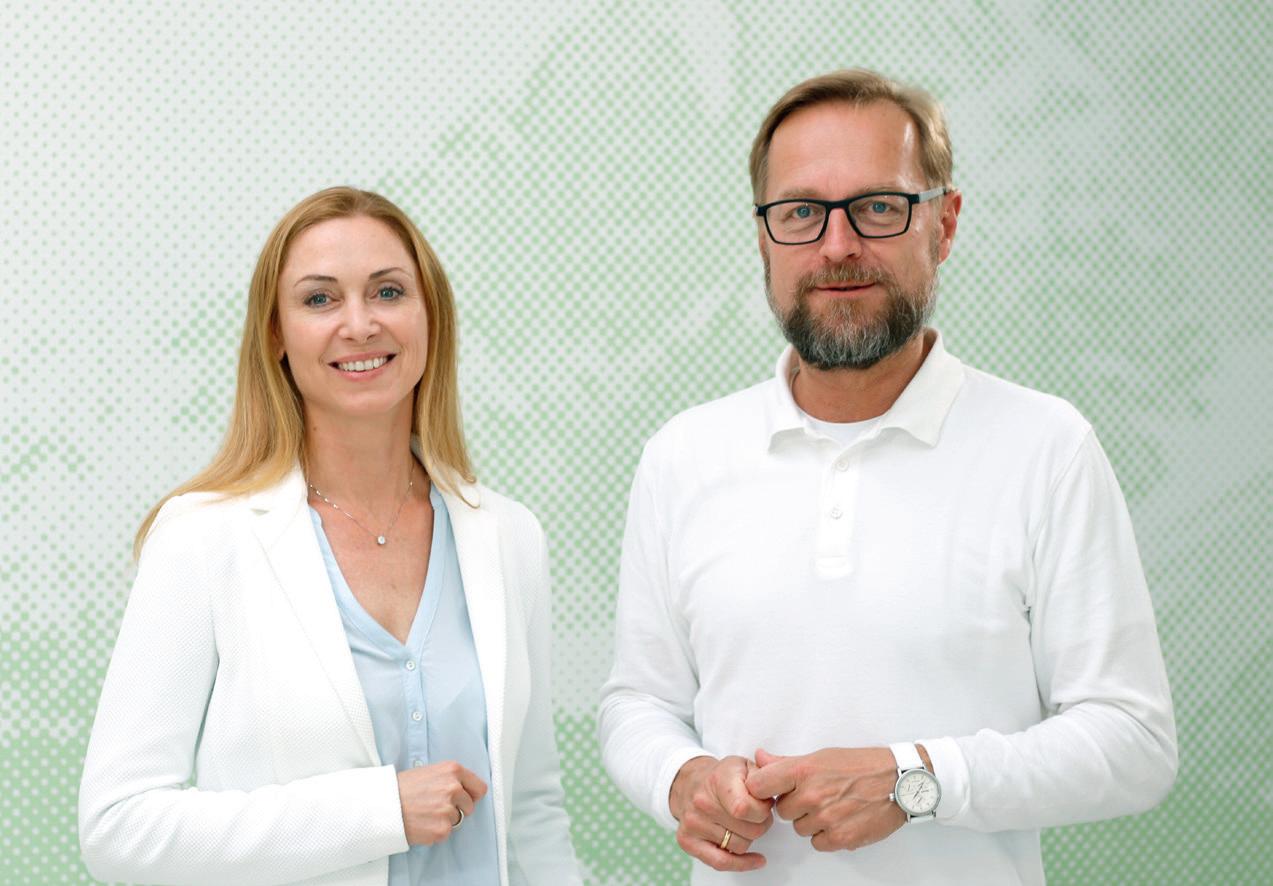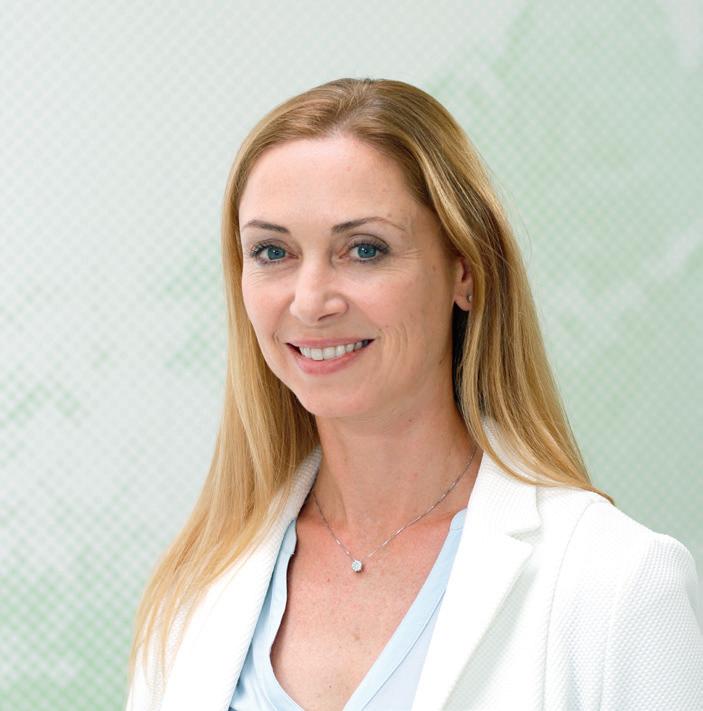
7 minute read
Strong, safe and sound
You feel well, no aches, no pains: no reason, then, to suspect osteoporosis. That’s exactly what most people are thinking while this bone disease might be present but as yet with no symptoms. Radiologist and osteoporosis specialist Dr Birgit Alexander-Suitner and Park Igls Medical Director Dr Peter Gartner explain this in the following interview. They also know what risk factors to be mindful of and the most effective measures to take for prevention. We are told that osteoporosis is becoming a global epidemic. Isn’t that a bit of an exaggeration? Birgit Alexander-Suitner: People’s awareness of the consequences of osteoporosis is still very low. The message that women should be tested as soon as they start the menopause has not yet been driven home. The estimated number of undetected cases is huge, so I’m wary of numbers. Without a clinical manifestation of osteoporosis, i.e. no bone fractures, the disease often remains concealed.
Peter Gartner: A study found that 750,000 Austrians suffer with osteoporosis, of which 600,000 are women. So, osteoporosis affects mostly women, but not exclusively.

Osteoporosis develops slowly, quietly and unseen. So it is possible for the disease to be present but asymptomatic. Gartner: Many of my patients are surprised when I ask them about osteoporosis. Even if their age places them firmly in the at-risk group and they have regular medical check-ups, most don’t think about taking preventive measures. I’d like to see people becoming more proactive.
Alexander-Suitner: It’s the same at our surgery. Reduced bone density is perfectly normal as we get older, but if it falls below a certain level, treatment becomes imperative. We call the difference between a patient’s measured bone density and that of a healthy young adult a T-score. If the T-score is below 2.5, then osteoporosis may be present. That doesn’t mean that the patients suffer from symptoms or limitations such as pain or fractures.
Gartner: Unfortunately, osteoporosis often remains undiagnosed until after injury, when it’s too late. Common osteoporotic fractures such as of the femoral neck or vertebrae often represent the beginning of restricted mobility in older people.
Are there prognostic symptoms for osteoporosis? Gartner: There are risk factors. Age, for instance: the rate of hip fractures increases between two and fourfold per decade between the ages of 50 and 90. Sex plays a role too, and women are more likely to be affected than men. Then there’s familial aggregation, or genetic make-up. Lifestyle factors such as smoking, a lack of exercise, and a poor diet that could be calcium and vitamin D deficient increase the chances of osteoporosis. People who are severely underweight, such as anorexics, are also at risk.
Alexander-Suitner: Secondary osteoporosis, i.e. bone loss resulting from specific clinical disorders, is something we don’t just see in anorexic patients. Preventive measures are also vital to help rheumatics on cortisone medication, as well as patients following chemotherapy, and those with thyroid disease or chronic inflammatory bowel diseases. People who are lactose intolerant or have been fitted with a gastric band can suffer impaired intestinal absorption of nutrients, especially calcium. They require regular bone density tests.
Gartner: This is where Mayr medicine comes into play. A cleansed gut that has been restored to good health facilitates the absorption of vitamins and trace elements from the intestines into the blood, and from there into the bones.
Do men suffer from osteoporosis? Alexander-Suitner: Yes, but it’s less common. Men who come to us for a consultation have often suffered low trauma fractures. Osteoporosis should definitely be considered as a cause when older men suffer unexplained fractures.
Gartner: We know that reduced oestrogen levels after the menopause can contribute to osteoporosis.
Women’s body frames are structurally different to men's in that they are smaller.
What else could help you recognise an abnormal reduction in bone density? Gartner: A GP should refer a patient for bone density testing if there is a noticeable reduction in height. I also frequently see a characteristic pattern of skin folds on the backs of patients in my surgery caused by the reduction in size of the vertebrae. In these cases, I also recommend diagnostic confirmation.

How does bone density testing work? Alexander-Suitner: The current gold standard is the DEXA scan, which uses low dose X-rays. It’s a quick, non-invasive investigation, and the radiation exposure is lower than you’d experience on a flight. In addition, X-rays of the thoracic spine and the lumbar spine help us discover hidden fractures that can occur, even if the T-score is normal. In our surgery we also work with TBS (trabecular bone score), which uses a software programme that allows me to have a look at the bone’s microarchitecture. As a result, I can better predict future fracture risk. It also enables me to monitor the success of a therapy more precisely. How often should you be tested? Alexander-Suitner: That depends on the examination results. Our radiology department carries out bone density and TBS tests. A questionnaire also provides us with information on risk factors and the possibility of secondary osteoporosis. The doctor in charge will also order blood tests to rule out hormonal conditions or disorders of the thyroid or the parathyroid. The result of the examination as a whole determines the frequency of further testing. Our device automatically compares the latest with past scores, which enables us to precisely document any deterioration as well as improvements.
So there can be improvements? Alexander-Suitner: Definitely. Appropriate treatment can stop osteoporosis and, in some cases, improve it – even in elderly patients. And it doesn’t always require medication.
Gartner: Bisphosphonates, the standard osteoporosis medication, used to cause digestive complaints. But they can now be administered by injection every six months or even annually.
How do you prevent osteoporosis? Gartner: Nutrition and exercise are both important in preventing osteoporosis, and should always form part of the treatment. We know from experience that the most difficult thing for patients is changing their lifestyles, so this is something we work on with people at Park Igls. As we mentioned earlier, calcium and vitamin D have a major role to play in preventing and treating osteoporosis.
Alexander-Suitner: We obtain calcium from milk and dairy products, especially hard cheeses. Calcium is also contained in cabbage, broccoli, eggs and meat. The body needs vitamin D obtained from sunlight to absorb calcium and enable bone mineralisation.
Gartner: Mayr intestinal cleansing creates the conditions for the healthy absorption of nutrients, because overacidification prevents calcium absorption. In his time, Erich Rauch, pioneer of Mayr Medicine and teacher to countless Mayr physicians, also considered overacidification the
main cause of many conditions. For instance, a glass of orange juice in the morning combined with food high in calcium, causes temporary overacidification and can lead to arteriosclerosis. This is why Mayr Medicine combines alkaline nutrition with the administration of alkaline substances or alkaline baths.
Alexander-Suitner: Vitamin D deficiency stops calcium being properly supplied to the bones. In our northern latitudes, our bodies have difficulty producing sufficient vitamin D in winter. This is why administering vitamin D has to be part of preventing osteoporosis.
Gartner: In summer, people should sunbathe without high factor sun protection, but for no more than ten minutes! This is the best way to obtain vitamin D while avoiding skin cancer.
What form of exercise is good for strengthening bones? Alexander-Suitner: In principle, any exercise that involves working the muscles is good: weight training, trampolining or power plate exercises to name just a few. Best of all, head out for some fresh air and sun. Although swimming is good for endurance training, it is not that effective for strengthening bones.
Gartner: The guests at Park Igls are taught physiotherapeutic exercises for osteoporosis that include special resistance band exercises. Balance and coordination exercises are also effective in preventing falls. Exercise nurtures bone metabolism and, as well as doing the body a great deal of good, it is also great for mental wellbeing.

Dr Birgit Alexander-Suitner
After her medical training at the University of Innsbruck, Dr Birgit Alexander–Suitner worked at the St. Vinzenz hospital in Zams/Tyrol. She began her GP training in 2004, and then completed her radiology studies in 2013. While studying her specialism, she also acquired a diploma in emergency medicine and qualified as a school doctor. Dr Alexander-Suitner is part of a specialist team of radiologists in Innsbruck, and bone density testing is one of her specialist areas. She’s an active member of both the Austrian and European societies of radiology (OERG and ESR).









